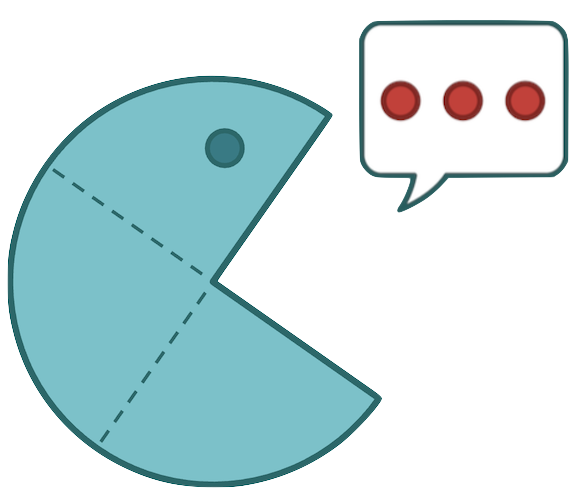
Mathematics is not just a set of interrelated concepts and skills. It is also a language. If we don’t explicitly teach the language of math, we are missing a foundational pillar needed to support student success.
Imagine…
A voice comes over the intercom at your school. There’s a lot of noise and commotion in the background. The voice says “Attention, math teachers! The location of your meeting with Principal Jenkins has changed to—” But you cannot hear the end of that sentence because of all the noise.
Wait, I needed to hear that part!
A significant part of comprehension comes through visual channels: lip reading, facial expressions, gestures, and props. But you can’t see the announcer. You’re in your classroom.
Conversely, imagine you have access to not one but three interpretive communication modes: listening, viewing, and reading. As the announcer speaks, a visual pops up on your phone with the text “New location: Room 117” along with a floor map with a big star showing where to go.
Does that fill in the part that you couldn’t understand before? Of course it does! Visual aids and text help your brain to fill in the gaps in your listening comprehension. As the fidelity of the communication grows, your comprehension also grows.
The same holds true for expressive language: speaking, writing, and representing. Combining these three expressive communication modes is going to improve the fidelity of your communications. Relying on a single mode is going to reduce the fidelity.
Now let’s apply this to the classroom. It’s easy to see how student comprehension of the content and their ability to express ideas would both increase as we integrate more modes of interpretive and expressive language with the math practices.
A Missing Pillar
The language of math is no one’s home language. It is a barrier not only for your multilingual learners, but for all learners. Explicitly teaching the language and vocabulary supports both math literacy and critical skills such as reasoning and modeling. In fact, the six communication modes are everywhere in the CCSS Standards for Mathematical Practice (SMPs): listening, speaking, reading, writing, viewing, and representing.
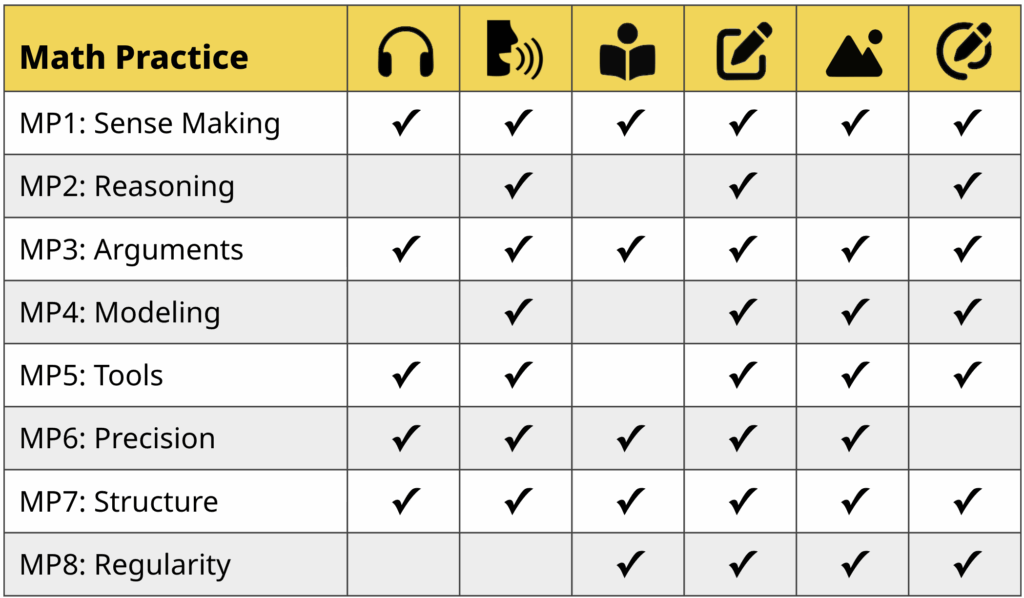
Looking for evidence that Math + Language works? Learn how one top-20 district increased math scores by 10.3 percentile points with a dosage of just four hours per month.
The following guide deep-dives the eight SMPs and illustrates how Speak Agent supports each one.
MP1: Make sense of problems. Persevere in solutions.
CCSS Requirement
- Mathematically proficient students explain to themselves the meaning of a problem and look for entry points to its solution.
- They analyze givens, constraints, relationships, and goals.
- They make conjectures about the form and meaning of the solution and plan a solution path rather than jumping right into trying a solution.
- They recall simpler forms of the original problem in order to gain insight into its solution.
- They monitor and evaluate their own progress and change course if necessary.
- Younger students may need visuals to help conceptualize and solve a problem.
- Older students can explain correspondences between equations, verbal descriptions, tables, and graphs or draw diagrams of important relationships, graph data, and search for patterns or trends.
- Proficient students check their answers to problems using a different method, and they continually ask themselves, “Does this make sense?”
How Math + Language Supports MP1
Speak Agent’s Math + Language program builds math literacy skills so that learners can comprehend, contextualize, and communicate mathematical information, problems, and reasoning.
Without the academic language of math, especially math reading skills, a learner will find it difficult to adhere to this practice because they may not understand what a question is asking, understand what information is needed to solve a problem, be able to compose explanations, communicate their thinking, or compare problem-solving approaches.
Math + Language helps students to acquire the content language to engage in this critical practice through activities that use all six communication modes (listening, speaking, reading, writing, viewing and representing)—especially math reading—with authentic math stories and situations.
Math + Language also uses stories and characters that model the process of persevering through problem solving. Examples include the Read Along and Tall Tales activities, such as the one shown below:

Shown above: This Read Along story models perseverance. In it, a summer camp team uses math concepts to come up with a flag design for their camp cabin.
MP2: Reason abstractly and quantitatively.
CCSS Requirement
- Mathematically proficient students make sense of quantities and their relationships in problem situations.
- They can abstract a situation, represent it symbolically, and manipulate the representing symbols.
- They can contextualize—pausing as needed during the manipulation process—in order to probe into what the symbols mean.
- Quantitative reasoning means they can create a coherent representation of the problem; consider the units involved and the meaning of quantities, not just how to compute them; and apply the properties of operations and objects.
How Math + Language Supports MP2
Speak Agent’s Math + Language program provides a variety of activities that take students through the problem solving process. These activities provide different levels of reasoning and learning scaffolds along the way using activities such as Explain Your Work (shown below).
Math + Language also builds fluency in all language domains, giving students more confidence in communicating their thinking and understanding abstract and quantitative concepts. It introduces each math concept and then provides concrete examples that are revisited in activities such as Word Gallery.
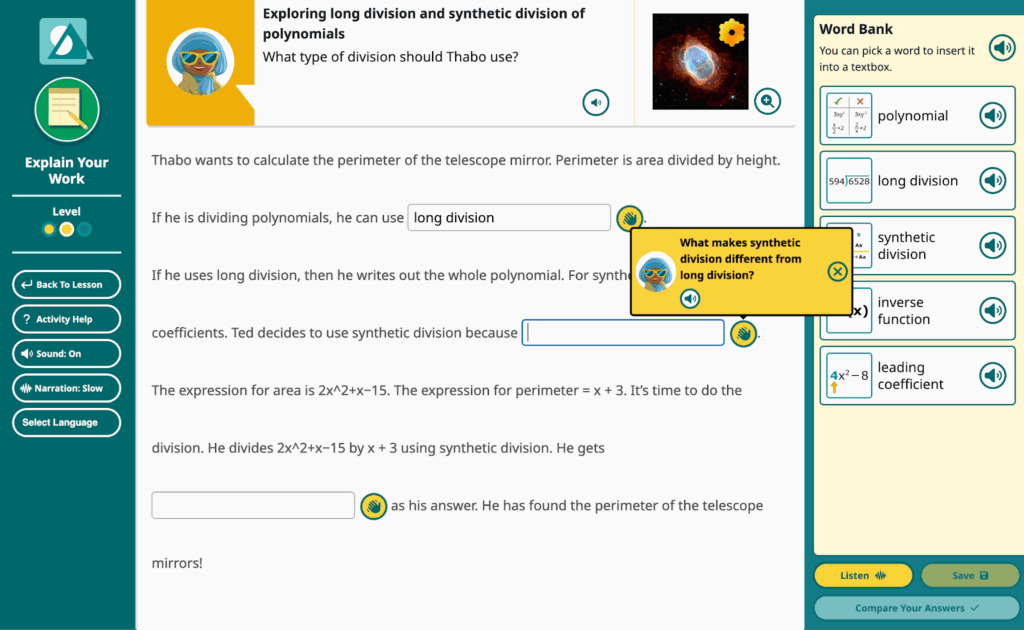
Shown above: Sentence stems in the “Explain Your Work” math reasoning activity.
MP3: Construct arguments and critique reasoning.
CCSS Requirement
- Proficient students construct arguments that use data in context.
- They make conjectures and analyze situations by breaking them into cases.
- They can use counter-examples, justify conclusions, and respond to arguments made by other students.
- They can listen or read the arguments of others, decide if they make sense, and ask questions to clarify the arguments. They can compare two arguments, detect flawed logic, and can explain the flaws.
- Younger students can construct arguments using concrete drawings and diagrams. Secondary students know how to generalize and apply an argument.
How Math + Language Supports MP3
Learners use Math + Language to develop knowledge of key math concepts and skills in comprehending and communicating their reasoning.
Specifically, learning activities that ask students to weigh and categorize evidence in activities such as Sort It Out and in scaffolded writing activities that ask students to explain their thought processes and compare against a model, such as Explain Your Work.
The program also provides diagrams, illustrations, worked examples, student-generated problems, and other referents used to build content knowledge concurrently with language skills.

Shown above: Evaluating evidence in the “Sort It Out” analysis activity.
MP4: Model with mathematics.
CCSS Requirement
- Proficient students apply math to solve everyday problems. In early grades, this includes writing an equation to describe a situation. By middle grades, a student can apply concepts to situations, such as using proportional reasoning to analyze a challenge faced by the local community.
- Students can make approximations to simplify complex situations. They identify key quantities and map relationships using tools like diagrams, two-way tables, graphs, flowcharts and formulae. They analyze relationships to draw conclusions.
- They can routinely interpret their results in the context of the situation and reflect on whether the results make sense, improving the model if needed.
How Math + Language Supports MP4
Math + Language uses authentic stories and problems that connect math to everyday problems and situations that are relevant and interesting.
Our lessons include activities such as Math Problem Maker (illustrated below) where students create math problems for classmates to solve. This strategy is vital because it takes students through every step of the math modeling process. It also provides writing scaffolds at each step.
Diagrams, tables, graphs, flowcharts, and relationship maps are also included in our Drawing Board visual representations activity.

Shown above: Gathering information in the Math Problem Maker writing activity.
MP5: Use appropriate tools strategically.
CCSS Requirement
- Proficient students know how to decide when math tools may be helpful, recognizing their utility and limitations. For example, high school students analyze graphs of functions using a graphing calculator. They detect possible errors by strategically using estimation. When making math models, they know that technology can enable them to visualize the results of assumptions, explore consequences, and compare predictions with data.
- They can identify relevant resources, such as digital content, and use them to clarify or solve problems. They use technology tools to explore and deepen their understanding of concepts.
How Math + Language Supports MP5
Math + Language focuses on acquisition of academic language and key math concepts. The stories in our activities model students using the appropriate tools for each particular situation.
We also treat the tools themselves as important unit vocabulary that students master during relevant digital lessons, as illustrated in the Word Gallery activity shown below.
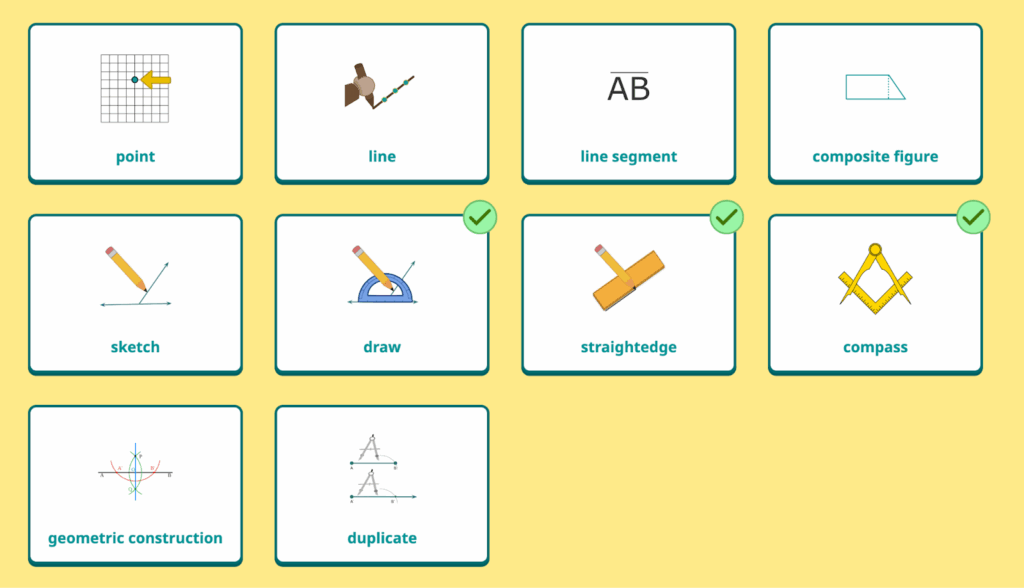
Shown above: The Word Gallery’s interactive word wall. Students may select a word to see multiple visual representations and read or listen to image captions and definitions at their own pace.
MP6: Attend to precision.
CCSS Requirement
- Mathematically proficient students work to communicate precisely with others.
- They use clear definitions in discussion and in their own reasoning. They state the meaning of the symbols they choose, including using the = sign appropriately.
- They are careful about specifying units of measure and labeling axes to clarify the correspondence with quantities.
- They calculate accurately and efficiently, expressing numerical answers at a level of precision appropriate for the context.
- At early grades, students give formulated explanations to each other. By high school they make explicit use of definitions.
How Math + Language Supports MP6
Academic vocabulary comes directly into play with this practice because math terminology tends to be highly precise. Math + Language helps students to develop a precise and nuanced understanding of each math concept and to be able to apply them correctly in varied discourse contexts.
Speak Agent activities also give students the opportunity to compare related words and to explore their differences. This enhances their understanding of which word to use in a given context, as illustrated in the Diagram It! activity below.

Shown above: Connecting related math concepts in the “Diagram It” activity.
MP7: Look for and make use of structure.
CCSS Requirement
- Mathematically proficient students look closely to discern a pattern or structure. Young students, for example, might notice that 3 + 7 is the same as 7 + 3. Later, students will see 7 × 8 equals 7 × 5 + 7 × 3. In the expression x2 + 9x + 14, older students can see the 14 as 2 × 7 and the 9x as 2x + 7x.
- They recognize the significance of an existing line in a geometric figure and can use the strategy of drawing an auxiliary line for solving problems.
- They also can step back to see the bigger picture and shift their perspective.
How Math + Language Supports MP7
Math + Language introduces new math concepts to students by connecting them to previously learned concepts.
When introducing a new mathematical structure such as parts of an equation or the order of operations, Speak Agent lessons emphasize the relationships among and the use of specific math terminology to help students see the repeated patterns in their math practice in the classroom.
Speak Agent often uses stories to explore patterns, such as in the Read Along activity shown below.
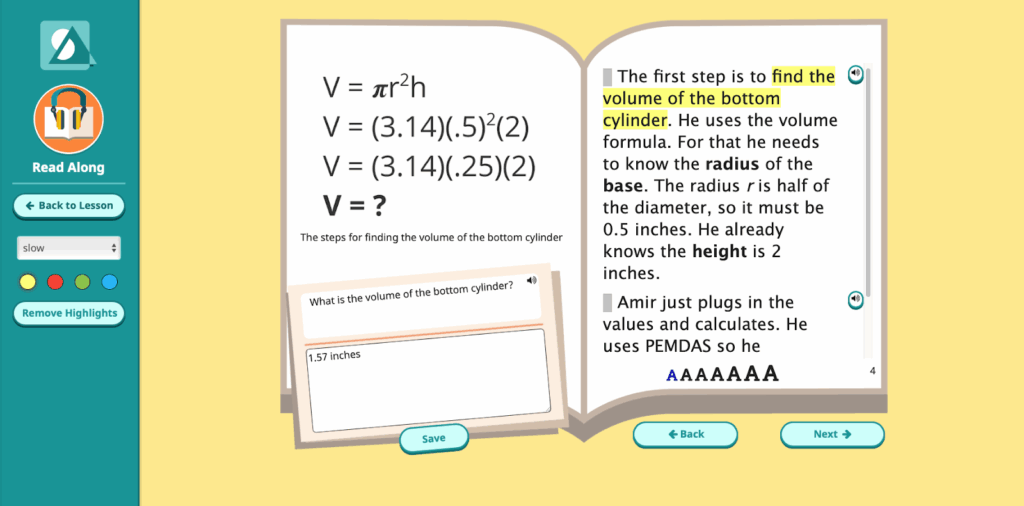
Shown above: One page of a Read Along activity. Most are 5 to 8 pages and have a C.R.O.W.D. prompt on each page that students must respond to before proceeding.
MP8: Look for and express regularity in reasoning.
CCSS Requirement
- Proficient students notice if calculations are repeated and look both for general methods and for shortcuts. Upper elementary students, for example, might notice when dividing 25 by 11 that they are repeating the same calculations over and over again, and conclude they have a repeating decimal.
- As they work to solve a problem, mathematically proficient students maintain oversight of the process, while attending to the details. They continually evaluate the reasonableness of their intermediate results.
How Math + Language Supports MP8
The Math + Language learning model is built to review the relevant academic language repeatedly throughout each unit. Students are first exposed to the abstract concept and then shown concrete or quantifiable examples numerous times in different authentic contexts.
Speak Agent activities like Tall Tales guide students through the reasoning process, gradually removing learning supports as they progress through the activities.

Shown above: Tall Tales, a cloze activity providing context for the problem-solving process.
Meet with us about math!
Discover how we can address your unique math lesson needs and priorities!

